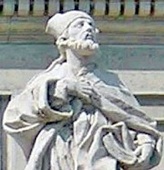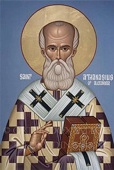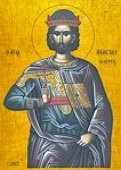


St Anastasius of Terni St Athanasius St Anastasius of Persia
Please be aware that what follows are the speculations of an amateur. If you have a serious interest, you would do well to consult the sources referenced below.
Introductory Section of the Legend
Although St Anastasius is the leader of the group of saints in the Legend of the 12 Syrians, he disappears from the legend at an early stage, after his execution in Rome. Everything up to this point is set in the reign of the Emperor Julian the Apostate (361-3), while the events that follow are set in periods that are significantly earlier or significantly later. The likelihood is therefore that this introductory section was added as a preface to pre-existing and initially self-contained legends, as a way of drawing them together and providing a common Syrian provenance.
The key facts set out in the introduction are as follows:
-
✴St Anastasius led a group of members of his extended family from Syria to Rome in the reign of Julian the Apostate.
-
✴The party took refuge in Rome with “S. Urbani Episcopi”.
-
✴St Anastasius ministered in Rome for a period, converting and baptising many pagans. However, when Julian heard of this, he ordered his arrest. When St Anastasius appeared before him, Julian asked him: “Quæ est, miseri, insania vestra?” (What, poor man, is your madness?), to which St Anastasius replied: “Insania nostra Christus est” (Our madness is Christ). The furious emperor ordered his incarceration, and then had him beheaded.
-
✴When St Anastasius was executed, his son, St Brictius led the rest of the family to safety along Via Cornelia. Two of the Syrians left the group at a place called “Pax Sanctorum”, after which St Brictius and the rest of the family continued to Spoleto.
Julian the Apostate
The author of the legend describes how Julian “returned like a dog to his vomit” (i.e. proclaimed his pagan beliefs) after he became sole emperor in 361. Since he died in battle less than two years later, the date that the ‘twelve Syrians”departed for Rome is closely defined.
There are a number of problems with this chronological setting, even if it is considered for the introductory section alone:
-
✴As noted above, St Anastasius and his family found refuge in Rome with “S. Urbani Episcopi”; the obvious implication is that they were welcomed by a pope called Urban. However, the only early pope of this name (Urban I) had died in 230. During the reign of Julian, there were two popes in Rome, the orthodox Liberius in the Lateran Palace and the Arian Felix in the suburbs.
-
✴Although Julian attacked many privileges of the church, he seems to have persecuted very few individual Christians. More specifically, there is no clear proof that he ever executed anybody on the grounds of his or her religious beliefs.
-
✴Finally, it is not clear how St Anastasius could have appeared before Julian in person: Julian never visited Rome after he became sole emperor, and nothing in the legend indicates that St Anastasius travelled to Constantinople (where Julian resided until July 362) or to Antioch (where he was based thereafter).
St Anastasius
The inspiration for the figure of St Anastasius remains a mystery, since he has no independent hagiographic identity. [What is the significance of the date 26th July which is given for the Passio et conversio ss. Anastasii et XII fratrum qui cum eo de Syriae partibus venerunt (St Anastasius and 11 brothers who came from Syria - BHL 1620) ???] Three figures need to be considered as possible sources of inspiration for this character, although none of them comes close to providing a full explanation of his presence in the legend.
St Anastasius of Terni
While some local historians have suggested that St Anastasius of Terni could have inspired the author of the Legend of the Twelve Syrians, this is roundly dismissed by the Bollandists.
-
✴Nothing in the legend suggests that, after arriving in Rome, St Anastasius the Syrian ever travelled elsewhere in Italy.
-
✴In addition, when the remains of St Anastasius of Terni were miraculously recovered in ca. 840, nothing was known about his life. Bishop Liutardus of Spoleto (ca. 829-44), who formally recognised the newly-discovered relics, appears to have made no connection between this figure and St Anastasius the Syrian. (Of course, this could simply point to a later date for the compilation of the legend).
St Athanasius (2nd May)
It is possible that St Athanasius provided some of the inspiration for the figure of St Anastasius the Syrian. He was the fiercely orthodox (i.e. anti-Arian) bishop of Alexandria in 328-73. The outlines of his turbulent career are as follows:
-
✴The Arian Emperor Constantius II exiled him in 339 and he fled to Rome, where he received protection from Pope Julius I. He initially spent three years there, and he then returned to the city during his journey back to Alexandria in 345.
-
✴Constantius II exiled him again in 356 and he spent the next six years living with the monks in the Egyptian dessert.
-
✴In 361, the Emperor Julian the Apostate issued a decree that allowed the exiled bishops to return to their sees. St Athanasius took advantage of this with undue haste following the murder of the man who had replaced him as bishop of Alexandria. Amid this turmoil, Julian exiled him yet again (see below), and he spent the next 10 months in the Egyptian desert. He was able to resume his position in Alexandria after Julian was killed in battle.
There are two things about St Athanasius that might have commended him to the author of the Legend of the Twelve Syrians:
-
✴St Athanasius was one of the small number of Christians whom the Emperor Julian did directly persecute. Julian demanded his exile in a letter (362) from Antioch to Ecdicius, Prefect of Egypt, adding in his own hand: “It vexes me greatly that my orders are neglected. By all the gods there is nothing I should be so glad to see ... as that Athanasius has been expelled beyond the frontiers of Egypt. Infamous man! He has had the audacity to baptise Greek women of rank during my reign! Let him be driven forth!” (Note, however, that this “persecution” fell some way short of a threat of execution).
-
✴St Athanasius was also responsible for the introduction into Italy of the eastern model of monasticism, one of the functions ascribed to St Anastasius in the Legend of the Twelve Syrians:
-
•The ascetic lives of the monks Ammonius and Isidore, who accompanied Athanasius to Rome in 339, caused a sensation there.
-
•St Jerome, in his commemoration of the lady Marcella, noted that she had first learned of the appropriate form of life for virgins and widows “from some priests of Alexandria, and from pope Athanasius, and subsequently from Peter, who had all fled for refuge to Rome to escape the persecution of the Arian heretics”.
-
•St Jerome (among other contemporary writers) attributed the “Vita Antonii”, a biography of the leader of the monks in the Egyptian desert in the 4th century, to Athanasius. It was translated into Latin soon after Athanasius’ death, and had a profound influence on monastic practice in the west. (Scholars still debate whether or not Athanasius actually was the author).
-
•St Jerome was himself inspired to live as a hermit in the Syrian desert in 374-9, and at this time wrote his “Vita Pauli”(the biography of another Egyptian monk), in which he mentioned the “Vita Antonii” and its Latin translation.
A detail in one version of the Legend of the Twelve Syrians supports the idea that St Athanasius provided inspiration for St Anastasius. This relates to the dialogue between St Anastasius and the Emperor Julian.
-
✴In most versions of the legend, the dialogue follows BHL 1620 (as above). Asked what is his madness, St Anastasius simply replies: “Our madness is Christ”.
-
✴However, in BHL 1622, the profession of St Anastasius is much fuller, taking the form of the orthodox (i.e. anti-Arian) Nicene Creed. In fact, as the Bollandists point out, the precise form used is that introduced in 381. However, the author of the legend could be forgiven for thinking that it was the response that the fiercely orthodox St Athanasius would have given.
However, it has to be said that there are problems with the hypothesis that St Athanasius was the sole inspiration for the figure of St Anastasius the Syrian. For example:
-
✴St Athanasius fled to Rome to escape persecution not of Julian but of his predecessor, Constantius II. Although he was exiled again by Julian himself, he managed to remain in hiding with the Egyptian monks on this occasion.
-
✴The precise number of his companions during his flight to Rome is unknown, but there is no evidence that any of them subsequently settled in central Italy.
In addition, of course, he has the wrong name. However, it is possible that the author of this part of the legend confused him with another eastern saint who was venerated in Rome, St Anastasius the Persian.
St Anastasius the Persian (9th July)
The Roman Martyrology records, under 9th July:
-
“At Bethsaloen in Assyria [modern Kirkuk], St. Anastasius, a Persian monk ... Chosroes, king of Persia ... caused him to be beheaded. ... His head was brought to Rome, at Aquae Salviae, together with his revered image, by the sight of which demons are expelled, and diseases cured, as is attested by the Acts of the Second Council of Nicea.”
The original legend of St Anastasius was written in Greek, catalogued as BHG 84. It related that St Anastasius served in the Persian cavalry before converting to Christianity and joining a monastery in Persian-administered Jerusalem in 620. After seven years there he moved to Caesarea, where he was arrested by the Persian authorities. He was taken to Bethsaloe (now Kirkuk in Iraq), where he was beheaded, along with 70 others.
Carmela Vircillo Fanklin and Paul Meyvaert (referenced below, at pp. 382-3) gave an account of the subsequent history of the relics, taken from another Greek legend, BGH 88. St Anastasius was buried at the monastery of St Sergius at Bethsaloe immediately after his execution on the 28th January, 628 (although this changed to the 22nd January in Latin translations). They were returned to the monastery at Jerusalem on the 2nd November 631. The details of the subsequent translation of the relics to Rome are unknown, but it seems likely that they were brought here by monks fleeing from Jerusalem after it fell to the Muslims in 638: the monastery at Aquae Salviae was a haven for such monks, and a guide for pilgrims (645) recorded it as the place “where the head of St Anastasius is, and where St Paul was beheaded ..”. The monks also probably brought BHG 84 with them, and it was translated into Latin as BHL 410b. A copy reached the monk Bede in England, and he ‘improved’ it BHL 408. Other Latin ‘improvements exist as BHL 410 and BHL 411.Faith Wallis (referenced below, at pp. 227-8) translated the relevant section of Bede’s ‘Chronica Maior’, and it also featured in his maryrology (below).
The Hieronymian Martyrology recorded under January 22nd:
-
“... romae ad aquas salvias sancti anastasi episcopi” (at Aquae Salviae, St Anastasius)
This entry is problematic, since the martyrology was written in the 430s or 440s. However, the later Martyrologies of Bede, Florus and Adon all described the monk and a martyr from Persia on this date, while the Martyrology of Usuard referred to him as a monk who was martyred at at Aquae Salviae.
Three facts support this Persian saint as one of the inspirations for St Anastasius the Syrian:
-
✴A copy of this legend of St Anastasius the Persian is included in the Leggendari del Duomo (under 24th January).
-
✴More significantly, some versions of the Legend of the Twelve Syrians have St Anastasius the Syrian executed by decapitation at a place that sounds like Aquae Salviae. For example, in BHL 1622, he was beheaded at “aquas salinas”.
-
✴After the execution of St Anastasius, his family fled along Via Cornelia. According to Emore Paoli (p 498 in the reference from 2000 below), this road ran alongside the monastery at Aquae Salviae.
The cult of St Anastasius came to particular prominence on a number of occasions in the early 8th century:
-
✴In 713, the relic of St Anastasius miraculously freed the daughter of a Syrian bishop from demonic possession. This became known as “the Roman miracle” and the monastery became an important centre of pilgrimage.
-
✴In 726, the icon of St Anastasius came to symbolise the resistance of Byzantine Italy to the imposition of iconoclasm by the Emperor Leo III .
-
✴In 729, the Lombard King Liutprand claimed to have had a vision while praying before the icon, following which he built a church dedicated to St Anastasius at Corteolona, near Pavia. (He had recently taken advantage of the furore over iconoclasm, made his peace with Pope Gregory II and then made this and a number of other gestures that were clearly intended to position him as the alternative to the Emperor Leo III as the secular head of the Church in the west.)
Emore Paoli (p 497 in the reference from 2000 below) has suggested that the place called “Pax Sanctorum”, where the party of survivors split up, was near Terni, and that it so-named for the peace conference between Liutprand and Pope Zacharius in 742.
The cult probably enjoyed another period of prominence when the issue of iconoclasm was revived later in the 8th century, causing an further influx of refugees from the east:
-
✴The Emperor Constantine V, the successor of Leo III, anathematised the veneration of icons was the Council of Hieria in 757, Pope Paul I made his own monastery of SS Stefano e Silvestro available to monks from the east.
-
✴Iconoclasm continued in the east under the Emperor Leo IV, the son of Constantine V, but was overturned when he died, leaving his wife Irene of Athens as regent for their young son. This made the way for the Second Council of Nicea (787), which brought the controversy to an end (at least until 815).
-
✴It is clear that St Anastasius the Persian was closely identified with at least the closing stages of this controversy:
-
-Representatives of Pope Hadrian I brandished the icon of St Anastasius at the Second Council of Nicea and celebrated its miraculous powers (as noted in the Roman Martyrology - see above).
-
-Following the Council, Irene of Athens dedicated a church in Constantinople as St Anastasios.
-
-Hadrian I rushed to Sancti Anastasii ad Aquas Salvias when it burned down in 789 to make sure that the relic had survived. He subsequently rebuilt the monastery.













